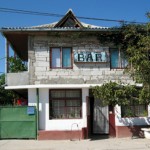When talking about Romania, Black Sea, and villages, everyone recalls 2 Mai and Vama Veche: alternative tourism under communism, chaotic development and the self-destructive force during transition. You think about the semi-legal tents and backyard tourism beforeand stadium-like densities, ugly blocks and swelling land rovers.
Well, here is a less known case study that can express transition duality at its best. Mamaia-sat perfectly informs the case of unleashed energies and the way back to normalcy after the fall of communism, and at the same time a new kind of destruction.
A Village
Mamaia village was never an old, picturesque village in Dobrogea. As much as most villages in the area, Mamaia and Navodari had a relatively regular grid, with more or less well-built houses, with no architectural value, yet quite nice with their narrow and deep gardens and vineyards. Their inhabitants were not really farmers since they had a job in the neighbouring chemical plants. However, the village was lucky enough to be located close to the main road and the sea shore. Thus, in early 1960s many intellectuals and families who rejected mass tourism found a refuge here. In fact, it was the same scenario as in 2 Mai, yet on a smaller scale and independent from the southern village fame.
Destruction
Mamaia-village was not lucky, since it was included in Ceausescu’s sinister plan of “rural systematization”. The word has it that comrade Ceausescu was flying in his chopper from the Danube – Black Sea Canal to Neptun, and when he saw the tiny dwellings and gardens he so much hated he ordered their demolition. The operation was carried out quite fast. The bulldozers came over and dug a ditch near every house and pushed each in the hole. It seems the workers hesitated the moment they were supposed to have the church demolished, and party activists looked around for a guy, got him drunk and had him drive the excavator. In the end, they levelled the ground, thus any trace of the village was erased. They planted peach trees there, but they would not yield any fruit. One of the dwellers died of a heart stroke, while the others were moved in match-like blocks, second class comfort, in Navodari.
From scratch
Just a few weeks after the downfall of communism, most of the former villagers met in the field and started to remake the village plan, working on the archaeology of their own village, so to speak. The only landmarks were the road, the lining trees and mariners’ barracks. They used the house foundations to retrace the property limits; the foundations had survived just because of the demolition method described above. The rest was made up again from personal memories and discussions: “from my house, the courtyard stretched over 4 m in width, and next to it was your lot, while the street was over there …” It took them quite a while to make it legal – and then the rest followed: ground measurements, the official recognition of the locality, electricity installation, and the quite flat names of lanes. Just like in the case of American towns, the streets are named by letters: M1, M2, etc.
The further development was uneven. Some stubborn families rebuilt their houses entirely, while others were content with some gardens and huts to live in when they visited. Finally, very many sold their piece of land sooner or later.
Meanwhile, some institutions were built, quite rapidly, such as the pub, the store, and a church. The latter is a metal and adobe building, a temporary “Holy Paraschiva”; now, they are building a new, brick one close to it with donated money.
Transition development
The whole Black Sea shore is about to become a wild front of buildings. The area I wrote about is no exception; the villas and newly built blocks tend to swallow the entire zone between the main road and the sea. Several buildings are erected in the village, and they do it in a wrong manner. The village is not as full as 2 Mai and Vama Veche, and since there are no bars, the place is not trendy; it is mainly chosen for houses (properties of the people from Constanta) and boarding houses. However, no one can stop the damage done to the beach and that grotesque mixture of affluent palaces, modest houses, and dusty lanes that feature the Romanian transition village. In fact, we are witnessing the parallel heroic revival of one community and its unrestrained change into something different. We hope that after destruction and massive change, it will reach a balance. Let us wait and see what is to happen in the years to come.
My acknowledgements and admiration to Aunty Marioara.


